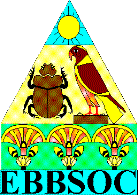| back::forward |

|
Egyptian Journal of Biology
Egyptian Journal of Natural History |
| Published by Egyptian British Biological Society (EBB Soc) | |
| Editors-in-Chief: | Professor Samy Zalat
(Suez Canal University, Egypt) Dr Francis Gilbert (Nottingham University, UK) |
| Co-Editors: | Professor Ismail Abdel Nabi
(Suez Canal University, Egypt) Professor Somia Salah El Din El Akkad (Ain Shams University, Egypt) |
| ISSN 1110-6859 & 1110-6867 | |
Address for manuscripts
via email: samysinai@yahoo.com
via post:
Professor Samy Zalat,
Egyptian-British Biological Society,
Department of Zoology, Suez Canal University, Ismailia, Egypt.
Instructions for authors
Manuscripts for the Egyptian Journal of Biology should normally not exceed 15 typed pages. Longer papers should be
submitted to the Egyptian Journal of Natural History, or discussed beforehand with the Editors-in-Chief.
The manuscript must be sumitted in the correct format
of the journal (see below, and also previous issues at the journal
webpages at http://www.nottingham.ac.uk/~plzfg/ebbsoc/ejb). We
now only accept manuscripts submitted electronically by email,
as a single MSWord document.
Journal papers should have a concise and informative title, followed by
the names and addresses of all authors. Indicate the author to whom all correspondence
is to be sent, and provide their telephone, fax and email.
The sequence of material must be: Title, Authors(s), Abstract,
Keywords, Introduction, Materials & Methods, Results, Discussion, Acknowledgments,
References, Figures (each numbered and with an informative legend), Tables (each
numbered and with an informative heading), and Appendices (if any). Please do
not use any other subheadings at all. Keywords should contain
terms not already in the title.
Please note that there must be separate Results and
Discussion sections, and that the Figures and Tables must not be integrated
within the text until the paper has been finally accepted. Please do not use
any of the formatting templates of MSWord. Papers not conforming to these
requirements will be returned for reformatting.
Final acceptance is contingent on the final version of the paper being
submitted in the correct format for the journal.
There are no charges for publishing papers in either journal.
Membership of the Society costs LE 30 for the first year of membership, LE 20 for each subsequent year.
Reprints of each paper (10-15 copies) can be provided on request only to authors
at a cost of LE 25 per page.
Detailed guidance on formatting papers
The Science
Abstracts should not be too long. They should be between
50-120 words only, and should summarise just the main take-home messages of
the paper. No methodological details should appear in the Abstract.
Please pay attention to the number of references used, which
should not be disproportionately large: over-referenced papers will be returned
for revision. It should be unusual to cite papers more than 15 years old, and
this should happen only with a very good reason. Papers should only be cited
that have actually been read by the authors: i.e., papers should virtually never
be cited secondarily, i.e. taken from other papers.
It is customary in Egypt to use many subheadings in
the Methods and Results sections: such subheadings should not be necessary at
all, and our journals dispense with them entirely. Please do not use any
subheadings.
Methods should not be referred to by author only (“protein
was determined according to the method of X...”), but brief details of what
was involved should be provided for people from outside the immediate field
who are interested in the techniques used.
Results and Discussion should always be separate
sections. The Discussion section should not restate the results, but should
discuss them in the light of what is already known, and their implications.
Repetition of data in the text that are already in
tables and/or figures is to be avoided: data should only appear once,
usually in a table or a figure. Any papers with such repetition will be returned
for revision.
Statistical analyses are usually essential.
especially in laboratory experiments that have a replicated design, and that
involve quantitative data. If quantitative data are being presented, but there
are no statistical analyses, there will need to be a strong argument about why
such statistical analyses are not appropriate. All figures reporting mean values
must have standard errors: these are required for all replicated
data.
Please include an Acknowledgements section to say who helped in the work.
The format
Please indent the beginnings of all paragraphs.
There should be no brackets around the numbers
of the Tables and Figures ! Thus “Table 1 shows that...”, not “Table
(1) shows that...”.
The phrases “Moreover,” “In contrast,” “Also,” “In
addition,” and “On the other hand,” at the beginnings of sentences seem to be
vastly overused in Egyptian scientific writing. They are usually unnecessary
or meaningless, and (for balance!) they should never be used in papers
submitted to our journals.
Please don’t use any of the preset Styles or
Formats of word-processors such as Word. They just cause endless problems later.
“and” should never
appear in a list of papers cited in the text. Lists of papers should be separated
either by a comma (Johns 1981, Stanley 1982) or by a semi-colon (Johns, 1981;
Stanley, 1982). Two-author papers should be “X & Y” rather than “X and Y”.
Please avoid using acronyms, which introduce
a significant barrier of understanding to the reader. Acronyms and technical
jargon should not be used unless absolutely essential, which it rarely
is. Clear simple description is what is required, so that your paper is readable
by all scientists, not just a small group of specialists. This is particularly
true of molecular studies.
In the Discussion, please avoid statements such as ‘The results
of the present study agree with author X...’. Instead, interpret
what the results mean, and cite author X.